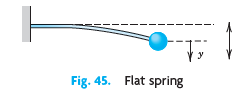The unifying power of mathematical methods results to a large extent from the fact that different physical
Question:
The unifying power of mathematical methods results to a large extent from the fact that different physical (or other) systems may have the same or very similar models. Illustrate this for the following three systems
(a) Pendulum clock. A clock has a 1-meter pendulum. The clock ticks once for each time the pendulum completes a full swing, returning to its original position. How many times a minute does the clock tick?
(b) Flat spring (Fig. 45). The harmonic oscillations of a flat spring with a body attached at one end and horizontally clamped at the other are also governed by (3). Find its motions, assuming that the body weighs 8 nt (about 1.8 lb), the system has its static equilibrium 1 cm below the horizontal line, and we let it start from this position with initial velocity 10 cm/sec.

(c) Torsional vibrations (Fig. 46). Undamped torsional vibrations (rotations back and forth) of a wheel attached to an elastic thin rod or wire are governed by the equation I0θ" + kθ = 0, where θ is the angle measured from the state of equilibrium. Solve this equation for k/I0?= 13.69 sec-2,?initial angle 30? (= 0.5235 rad) and initial angular velocity 20? sec-1 (= 0.349 rad ? sec-1).

Step by Step Answer:






